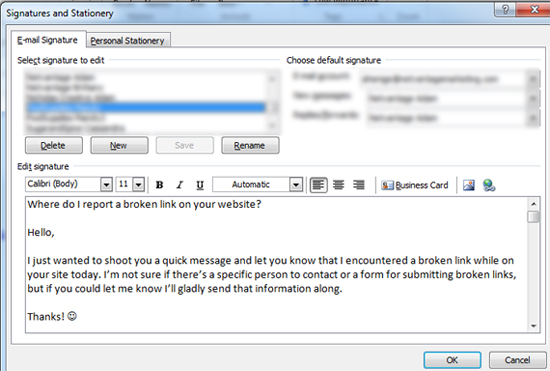Last Updated on June 3, 2013 by Netvantage
If you’ve been around the Netvantage blog you’re probably aware that we do a lot of broken link building. We’re not bashful about providing some tips, building tools or just talking about the topic – see here, here, here, here and here (anchor text doesn’t matter anymore, right?).
So at a weekly meeting last week I asked everyone on staff to send me some of their favorite tips, tricks and tactics for broken link building and some of them actually paid heed to my request.
First, however, here are some of my helpful hints.
Adam Henige
For me I’ve come to realize that you can either go for quality or quantity in broken link building, and different scenarios call for each. Regardless, productivity is a big deal. I’m an Outlook user, so for me setting up signature templates for my campaigns is a HUGE time saver. The nice thing is once you’ve done this for a while you can very easily setup the email account you’ll be using with a signature that is 80-95% complete and you’ll just need to populate a few personalized details to send out your initial outreach email. Even better, once you’ve done this business long enough you’ll start realizing that nearly all of your email responses can be templated as well, and you can set up your reply signature to contain the majority of your templated response, too. Why re-type the same information over and over? Even if you end up rewriting 75% of your reply, the time saved is significant when you’re sending out hundreds of emails.

The other item you’ll notice in the template above is something that I let out in an interview a while back – seeming as benevolent as possible. Look, everyone’s leery of anything that even resembles phishing at this point. You want info, in particular an email from a webmaster, people are going to have their defenses on high alert. If you can find ANY way to assuage those fears you’re doing yourself a favor. That’s why I try to toss in benevolent touches like “or a form for submitting broken links”. See what I did there? I made it more clear that I just want to send the info along. I make it sound like that’s as good as contacting a person because all I want to do is let someone know the site has some issues. Of course, very few sites have forms to submit broken links, so as long as you pass the sniff test of not being a rogue internet terrorist you’re far more likely to get that initial response. Subtle touches like these can up your response rate a few percentage points and in a high volume game this can make a big difference over time.
Lauren Shelton
I have a tool I have found useful for finding emails on-sites, it’s called Tout. It highlights them and puts them in a box at the top right corner of your screen, saving time and energy. You can add it to your Google Chrome browser here: https://chrome.google.com/webstore/detail/gllmkcahdekdbapmdfnffclacbpnicaj.
I have also found that using Yelp to find broken links can be useful depending on the client. I found several broken links to inns/hotels using the following search query in Google: site:www.yelp.com intitle:closed intitle:charleston inn. Then I browse through the closed businesses yelp profile. For those that still list websites, I can throw them into Open Site Explorer to see the backlinks. Then it’s easy to reach out to sites about the broken link and offer our client’s as an alternate.
Mike Hall
My most successful broken link building stories have come from finding dead or dying resources, making them 10 times better than what they were in the past, and then informing those that link to the old resources know what I’ve created. In order to speed up this process of finding these dead resources, I make big lists and do things in bulk. The best ways of finding broken links in bulk might be a topic for another post, but quickly going through a list of potentially awesome dead resources is fairly easy.
I’ve made a Broken Link Research template that you can download and use yourself, but if you’re interested in the specifics of using and recreating it, read on.
Assuming you already have a nice list of dead resources, use Majestic’s bulk backlink checker to get a sense of the potential links your future resource could get. I like to only use external backlinks, referring domains, and referring IPs to avoid making things too confusing. To find out what the broken links used to look like and if they are worth recreating, we’ll use the Wayback Machine. You can also get a sense of the quality of dead resource by looking at its anchor text information, which can be found from Open Site explorer. Use the concatenate function to combine the text “http://wayback.archive.org/web/*/” and “http://www.opensiteexplorer.org/links?page=1&site=” with the broken link URL, and then use the URL opener to access all that information at 25 URLs at a time.
Once I find a nice collection of broken links, and am ready to begin the contacting process, I like to organize these gold nuggets by bookmarking them in my browser. Bookmark the backlinks pages for each of the broken links in either Majestic or Open Site Explorer, and organize them in bookmark folders by clients and/or pages you’re aiming to build links to. This method is a whole lot easier if you have something like the Link Building Toolbar that tracks what websites you’ve contacted or visited already.

Leave a Reply